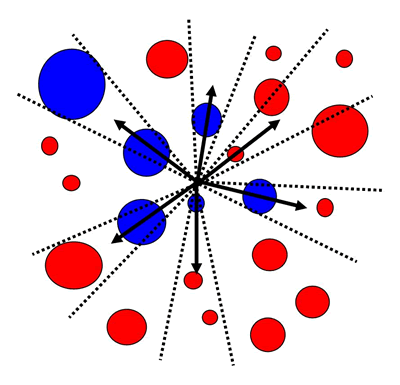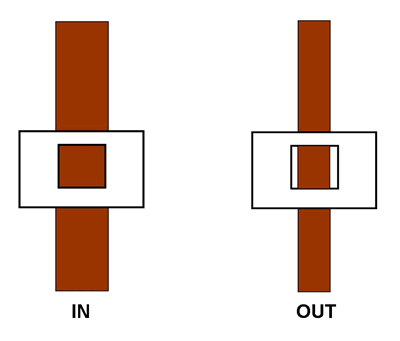

forestandrange.org home || learning options || further assistance
Lesson 5: Establishing Variable Plots
Review and Introduction
In Lesson 4, we talked about fixed area plots. Now we will talk about a different kind of plot, which is a variable area plot.
Learning Objectives:
By the end of this lesson, you should be able to:
- Understand how a variable plot works
- Choose an appropriate prism factor
- Use a prism to determine “in” trees
- Understand what the trees in the “plot” represent in the larger stand
Materials Needed:
- Keyhole or glass wedge prism(s)
- Colored survey ribbon
- Orange timber marking crayon (optional)
- Permanent Marker (optional)
I. Variable plots
Unlike fixed plots, which have a defined area, variable plots do not have a specifically defined plot area around the plot center. A special prism tool is used to determine whether a tree is “in” or “out” rather than the tree’s location within a defined boundary. The larger a tree is or the closer it is to plot center, the greater likelihood of it being an “in” tree.
Conceptually, the prism serves as an angle gauge to determine which trees are “in.” Figure 5-1 shows a schematic of a variable plot, in which the prism, acting as an angle gauge, is applied in several different directions. Trees intersected by the angle are in (shown in blue), while trees cleared by the angle are out (shown in red). Note how trees have to be larger to be considered in the further they are from plot center.
Variable plots are not as conceptually straightforward as fixed plots and they require additional, specialized tools (prisms). However, the procedures for laying out a variable plot may be faster and easier than a fixed plot, especially if you are working alone, on a steep slope, or with lots of brush.
 |
| Figure 5-1: A schematic of a variable plot, where a prism, acting as an angle gauge, is applied in several different directions (indicated by the arrows). Trees intersected by the angle (indicated by the dotted lines) are considered “in” trees (shown in blue). |
Variable plot are not as conceptually straightforward as fixed plots and they require additional, specialized tools (prisms). However, the procedures for laying out a variable plot are almost always faster and easier than a fixed plot, especially if you are working alone, on a steep slope, or with lots of brush.
II. Different prism factors
As with fixed plots, you want to have, on average, 5-10 trees per plot. To get the appropriate number of trees per plot, you will need to select the appropriate prism basal area factor (BAF). If your stand has, on average, larger trees, you will want to use a larger BAF (e.g. a BAF of 40). If your stand has, on average, smaller trees, you will want to use a smaller BAF (e.g. a BAF of 10 or 20).
[Sidebar] What the basal are factor means is that any tree that is determined to be an “in” tree represents that amount of basal area in the stand on average. Basal area is the cross sectional area of the trunk of a tree at breast height (4.5 feet above the ground). For instance, if establishing a variable plot using a BAF 40 prism, every in tree would represent 40 square feet of basal area–regardless of the actual basal area in each individual measured tree. Thus if you had three trees in a BAF 40 plot, it would represent 120 (3 x 40) square feet of basal area per acre. The cumulative amount of basal area in a stand reflects both the size and density of the trees and is used commonly as a measure of whether or not the stand should be thinned – but more on that in later lessons.
Since basal area is directly related to a tree’s diameter, you can use mathematical formulas to take a tree’s diameter and the BAF used and compute that tree’s expansion factor (trees per acre). However, for our purposes now, determining figures such as basal area and trees per acre are not as important when taking the field measurements. These calculations will come later and can be done manually (as we will demonstrate in Lesson 10), or using the Inventory Wizard and the Landscape Management System (LMS). LMS will compute such figures automatically (as we will demonstrate in Lesson 7 and Lesson 8).
The most important purpose of the BAF when doing field measurements is to choose one that will give you the desired average number of trees per plot. Remember that each prism has a fixed BAF. Similar to fixed plots, once you have selected the prism that you are going to use, you need to stick with it for each plot in the stand.
II. Using a prism
There are several types of prisms. A glass wedge prism is a piece of glass that has been specially cut to deflect light and displace the tree image. They are calibrated and are very precisely made. Holding the prism over plot center, look at the trunks of the trees around you (at breast height) through the prism. The trunk of the tree as seen through the glass prism will be shifted. If the shifted image of the tree trunk overlaps what you see with your naked eye, the tree is in. If the shifted image of the tree trunk is completely separated from what you see with your naked eye, the tree is out (Figure 5-2). Make sure that as you work your way around the plot, you keep the prism fixed over plot center while you move around it. If you are on a slope, tilt the prism so that the bottom of the prism is parallel to the slope. You will see as you move around the plot that the further from plot center a tree is, the larger it must be to be considered in. The selection of in trees is thus a function of DBH and distance to the plot center.
 |
| Figure 5-2: Looking at the stem of the tree (at breast height) through a prism will shift the image of the tree. If the shifted image overlaps (example on the left), the tree is in. If the shifted image is completely separated (example on the right), the tree is out. |
![]()
Watch a video clip of how to use a glass prism
Glass wedge prisms are delicate and expensive, and you may need several different ones for different BAFs. A durable, inexpensive alternative that can replace several glass prisms is a keyhole prism, such as a “Cruz-All.” A keyhole prism is not actually a prism, but is a tool that serves the same angle-gauge function. It has openings of various widths corresponding to commonly used BAFs.
Unlike the glass prism, with the keyhole prism your eye should stay fixed over plot center rather than the prism. The keyhole prism has an attached chain to help you keep it a prescribed distance from your eye as you look through it. Hold the end of the chain up to your face and hold out the keyhole prism so that the chain is taut. As you pivot around your plot center, look at trees through the opening that corresponds to your desired BAF. If the tree stem (looking at it at breast height) completely fills the opening, the tree is in. Otherwise, it is out (Figure 5-3).
 |
| Figure 5-3: When using a keyhole prism such as a Cruz-All, keep over plot center and use the chain to hold the prism the appropriate distance from your eye. Look through the opening that corresponds to your desired BAF. If the tree stem completely fills the opening (example on the left), it is in. If it does not completely fill the opening (example on the right), it is out. |
![]()
Watch a video clip of how to use a keyhole prism
As with fixed plots, you may occasionally run into a borderline tree. There are some precision distance measurements that you can do to determine whether the tree is in or out but that is beyond the scope of this lesson. In most cases, you should be able to make a reasonable estimation of whether the tree is “in or out.”
|
Next Steps:
- Test your knowledge by taking a Short Quiz.
- Go to the Next Lesson.
